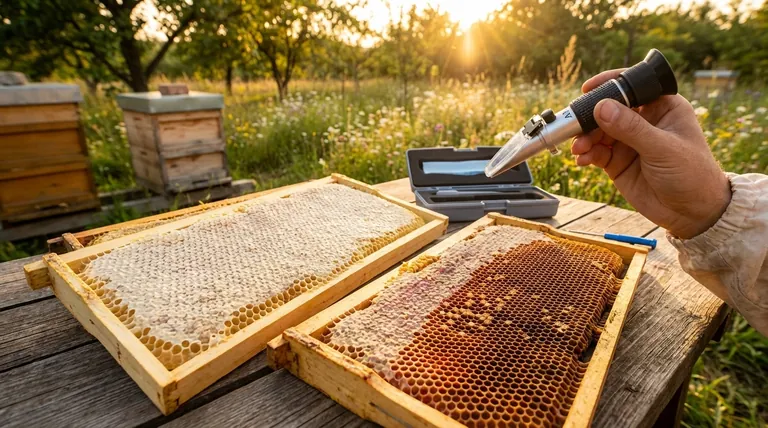Grading honey is a critical step for ensuring the quality, stability, and long-term durability of the final product. It is a sorting process performed before extraction that separates high-quality, stable honey from lower-quality honey that is prone to spoilage. This simple act of classification protects the entire harvest from potential degradation.
The core purpose of grading is not about appearance, but about risk management. It is the essential practice of separating honey based on its stability to prevent a small amount of high-moisture honey from spoiling an entire batch through fermentation.

The Core Principles of Honey Grading
Grading is done by inspecting the combs before the honey is extracted. This visual assessment allows beekeepers and processors to identify key indicators of quality and stability.
Distinguishing Between Grades
The primary distinction is between first-grade and second-grade honey.
First-grade honey is typically lighter in color and comes from combs that are predominantly sealed with wax. This is the highest quality product.
Second-grade honey is often darker or more yellowish and is found in combs that contain unsealed honey cells or a significant number of pollen cells.
The Critical Role of Sealing and Moisture
The most important factor determining honey's stability is its moisture content.
Bees seal a cell of honey with a wax cap only when they have reduced its moisture content to around 17-18%. This low moisture level prevents the growth of yeast and bacteria, making the honey shelf-stable indefinitely.
Unsealed honey has a higher moisture content, making it susceptible to fermentation. Therefore, the presence of sealed combs is the most reliable visual indicator of stable, first-grade honey.
Key Factors in the Grading Process
While a visual inspection of combs is the first step, a complete grade is based on several key metrics.
- Color: Serves as a quick visual indicator. Lighter honey in fully sealed combs is generally considered higher grade because it suggests low moisture and purity. Darker combs often contain unsealed honey or pollen.
- Moisture Content: This is the most critical factor for durability. Honey with moisture content above 20% is at high risk of fermenting.
- HMF (Hydroxymethylfurfural): HMF is a compound that forms in honey when it is exposed to heat or has aged. Low HMF levels indicate fresh honey that has not been overheated during processing, preserving its delicate flavors and enzymes.
The Critical Risk of Not Grading
Failing to grade honey before extraction introduces significant and often irreversible risks to your entire harvest.
The Threat of Fermentation
This is the single greatest danger. When high-moisture (second-grade) honey is extracted and mixed with low-moisture (first-grade) honey, it raises the average moisture level of the entire batch.
If this average moisture level creeps into the fermentation zone, the yeasts naturally present in honey can begin to multiply, spoiling the entire container.
Impact on Storage and Shelf Life
Properly harvested and separated first-grade honey can be stored for extremely long periods. Its low moisture content makes it one of nature's most durable foods.
Second-grade honey, however, degrades quickly. It is not suitable for long-term storage and must be used or processed promptly. Mixing the two compromises the shelf life of your premium product.
Why Timing Is Everything
The references are clear that grading must be done before extracting honey from the combs.
Once honey from different combs is mixed in the extractor, separation becomes impossible. The decision to sort the combs is the one and only opportunity to protect the quality of your premium honey.
Making the Right Choice for Your Harvest
Use these guidelines to apply proper grading practices based on your goals.
- If your primary focus is long-term storage: You must separate sealed, light-colored combs from any unsealed or dark combs before they enter the extractor.
- If your primary focus is maximizing quality: Process your first-grade (light, sealed) honey separately to create your premium product, ensuring its purity and stability.
- If you have a mix of grades: Treat second-grade honey as a separate product for immediate consumption or for use in products that will be consumed quickly.
Proper grading is the fundamental step that protects the value and integrity of your hard-earned honey harvest.
Summary Table:
| Grade | Key Characteristics | Primary Use & Stability |
|---|---|---|
| First-Grade | Light color, predominantly sealed combs, ~17-18% moisture | Premium product, suitable for long-term storage, shelf-stable |
| Second-Grade | Darker/yellowish, unsealed cells, higher moisture content | Immediate use, quick consumption, high risk of fermentation |
Protect the quality and value of your honey harvest with the right equipment.
Grading honey correctly requires reliable tools for inspection and processing. HONESTBEE supplies commercial apiaries and beekeeping equipment distributors with the durable, wholesale-focused supplies needed to implement an effective grading system.
From uncapping tools to storage tanks, our equipment helps you separate first-grade and second-grade honey efficiently, safeguarding your entire batch from spoilage.
Contact HONESTBEE today to discuss your apiary's needs and ensure your harvest meets the highest quality standards.
Visual Guide

Related Products
- Precision Honey Refractometer Instrument for Quality Assessment
- Easy Use Manual Stainless Steel Honey Press for Honey Comb
- Natural Wood Honey Dipper for Tea Coffee and Desserts
- 10L Stainless Steel Electric Honey Press Machine
- Stainless Steel Honey Press Wax Press with Tank
People Also Ask
- What are the key points for proper usage of a honey refractometer? Ensure Accurate Moisture Readings Every Time
- What are the key steps to using a honey refractometer? Ensure Honey Quality & Prevent Fermentation
- What is a honey refractometer and what is its purpose? Ensure Honey Quality and Prevent Spoilage
- Why is a honey refractometer considered essential for commercial beekeepers? Ensure Honey Quality and Profitability
- What is a honey refractometer? The Essential Tool for Perfect Honey Quality



















